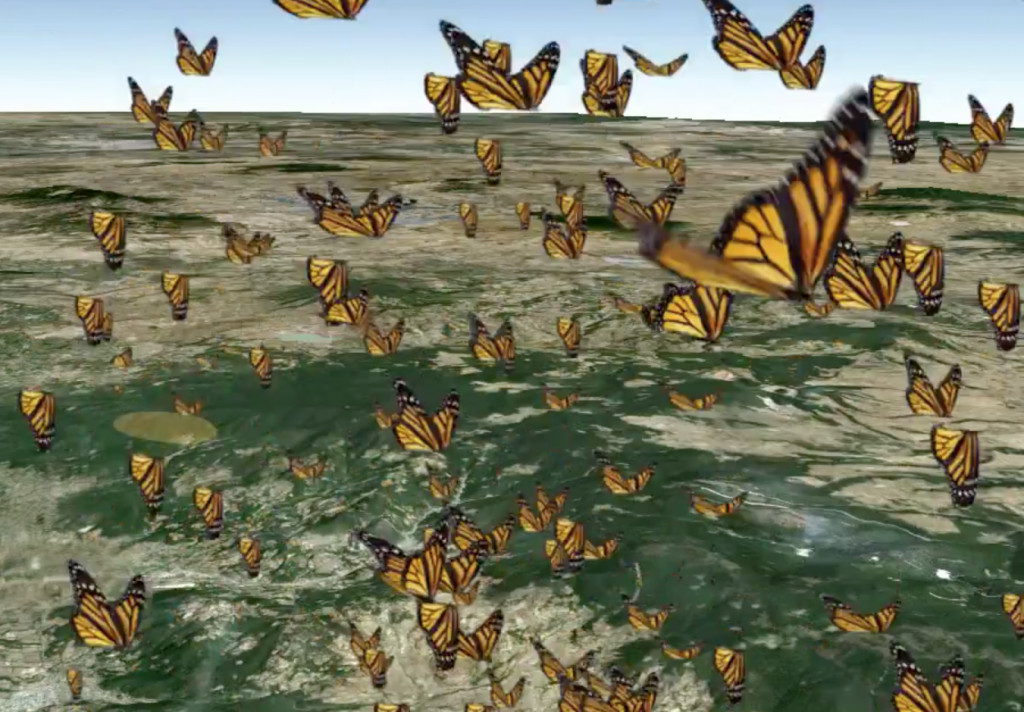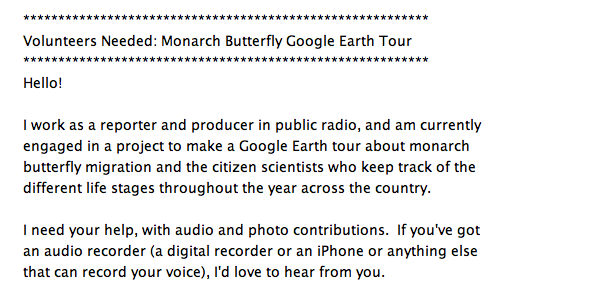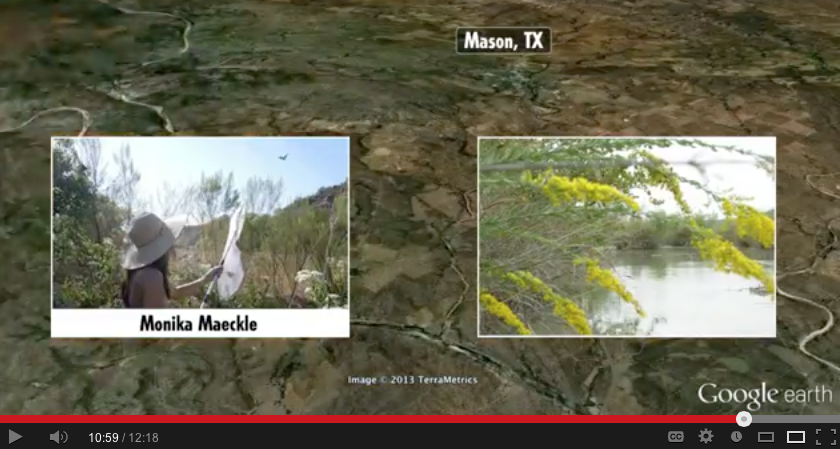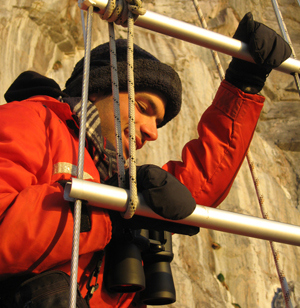Some stories never grow old no matter how often we hear them. Especially when cool, appropriate technologies are tapped to amplify a known tale with delightful graphics and interesting maps.

Google Earth Tour of Monarch Butterfly Migration marries their epic journey with epic technology. Photo via EncyclopediaofLife
Such is the case with the recently released Monarch Butterfly Google Earth Tour, produced by Ari Daniel Shapiro and the gang at Atlantic Public Media and the Encylopedia of Life.
Sometimes technology injected into a natural phenom like the Monarch migration can seem intrusive and inappropriate. But in this case, Google Earth mapping software lends a new perspective to the Monarchs’ epic journey, providing differing perspectives–from Monarchs’ flying in the sky to citizen scientists on the ground.
What is a “Google Earth Tour“? As you may know, Google Earth is an amazing 3D virtual globe software program that allows one to travel the world without ever leaving your desk. Developed by the CIA-funded Keyhole, Inc., and purchased by Google in 2004, the technology makes it possible to give a “tour” of most patches of the planet without ever leaving home. The program also uses digital modeling data collected by NASA to provide 3D views of faraway places.
Shapiro said the idea for the tour resulted from a reporting trip he took to Winnipeg, Canada, last year. “I visited someone’s home who had a monarch butterfly waystation. I thought about how far those butterflies had to travel, and the way in which people feel connected to these insects. It felt like it would make a great story,” he said via email.
Shapiro, like the Monarchs, starts this virtual tour in March in Michoacán. Environmental geographer Dr. Isabel Ramirez of the Universidad Autonoma de Mexico tells us that Monarchs are “small pieces of sunlight.”
From there, they journey north. Dr. Karen Oberhauser of the University of Minnesota’s Monarch Lab details their travels through northern Mexico, the “Texas funnel,” on to the spring ranges in the Midwest and then to the summer breeding grounds further north. The first half of the 12-minute video provides a view from the butterflies’ perspective, flying high above the varied terrain, stopping periodically to lay eggs and continue the life cycle. Given the obstacles–ants, birds, wasps, diminished habitat and climate change–their tenacity is remarkable. In her plainspoken Minnesota accent, Dr. Oberhauser declares: “Yeah. It’s incredible.”
Then Shapiro switches gears. He introduces citizen scientists and butterfly lovers, from Mark Garland and Paige Cunningham in New Jersey to Mary Beth Curry in Sylvester, Georgia. Garland and Cunningham tag Monarchs near Cape May, and Cunningham likes to whisper “Have a good journey” upon releasing them to fly on their way. Curry, a teacher, shares Monarch caterpillars with her students.
The story continues into Fall when the butterflies arrive at our famous Texas funnel–the channel through which ALL migrating Monarchs must pass to reach their ancestral roosts in Mexico. That’s where we come in.
I heard about Shapiro’s project through the DPLEX email list, an old style email listserv that reaches hundreds of professional scientists, citizen scientists, and butterfly lovers. Journey North had forwarded Shapiro’s solicitation for volunteers in which he invited contributions of audio files and photos for the project.
________________________________________________________________________
 _________________________________________________________________________
_________________________________________________________________________
I couldn’t resist, so in early December of 2012, I contacted Shapiro. My contribution appears in minute 10:51, where he plays my allergy congested sound bite, which describes Monarchs “clustered like grapes” on the pecan trees that line our stretch of the Llano River, a favorite Fall overnight roosting spot.
Shapiro also plugged in a couple of my photos, including a shot of family friend Annie Alice Schenzel of Austin with her back to the camera, netting Monarchs on the Chigger Islands. The caption reads “Monika Maeckle” and as much as I wish I were 24 years old again, that’s not the case.

Nope, not me. That’s Annie Alice Shenzel of Austin, TX. That IS my voiceover, though. Photo via Encyclopedia of LIfe
When the video came out, I contacted Shapiro, but it was too late to make the change. Lucky for us, Ms. Schenzel is gracious in being misidentified. “I am not even close to being offended by this,” she relayed via email, when told about the mix-up. Thanks, Annie!
The entire project would not have been possible without the new technologies that bind and sometimes divide us. In fact, citizen science would be nowhere near its current zenith without crowdsourcing tools like Facebook, Twitter, Google Earth, listservs, Smartphones, and blogs/websites like the one you’re reading. We would all be marveling alone, unable to share the wealth of magic and information.
More posts like this:
- How to tag Monarch Butterflies
- Monarch Butterflies: the Panda Bears of Climate Change?
- Tracking the Monarch Migration from Your Desk
- A Year in the Life of a Mostly Native Urban Butterfly Garden
- As the Earth Heats Up, What Does it Mean for Monarch and other Migrating Butterflies?
Like what you’re reading? Don’t miss a single post from the Texas Butterfly Ranch. Sign up for email delivery in the right navigation bar on this page, like us on Facebook, or follow us on Twitter, @monikam.


This film sure is amazing. I have been showing it to many people up and down New Zealand, so that people gain a better understanding of the marvellous Monarch migration. So that’s what you don’t look like from the back, Monika! 🙂
Joking aside, it is very well done. Kudos to you, Mr Shapiro.
I just watched the Google Earth video. Very nicely done!
Thanks for sharing this Monica! Nice to hear your voice. Fantastic video they made.
What an amazing video. I will definitely be forwarding it to many people.
I have only seen 2 Monarchs this Spring/Summer…so sad:( My tropical Milkweed is not looking so good. Do you happen to know of another variety of Milkweed that would perform well in SA, TX? Do you know of any garden centers that sell native Milkweed? Another problem I’m dealing with is that I have lots of shade in my garden and butterflies like the sunshine.
Steph – have you checked Monarch Watch’s Milkweed Market?
(http://monarchwatch.org/milkweed/market) They have been selling native milkweed. Asclepias variegata (white milkweed) is native to TX and needs to grow in the shade (edge of woods). Not sure if monarchs will be attracted to it, but it can’t hurt!
You might try Swamp Milkweed, Asclepias incarnata, if you have a damp situation, but it needs sun as do the others.
Science becomes magic…
Very nice project indeed. I just wish there had been some interviews on the Mexican side (besides Dr. Ramirez) , as there is a great project called Correo Real (Royal mail) that monitors the monarch migration through Mexico, and reports to Monarch Watch. There are hundreds of citizens, many school teachers, reporting numbers and locations, taking notes, pictures, etc. and sending them to Ms. Rocio Treviño, the project manager, and those are published in a e-newsletter every week.
Very interesting, Alida. What is the name of the e-newsletter and how do we sign up? Thanks for writing.
Thanks Monika. Write to Rocío Treviño at and just ask her to include you in the list. It is nothing fancy but hope you like it. ;D
The San Antonio Botanical Garden greenhouse group often has native milkweed for sale.
Thanks, Monika, for all you do for the monarchs!
Formerly from Philadelphia PA where occasional Monarchs were greatly admired. Looking for sightings here in San Antonio TX.
Either we all are missing something or else the Monarchs are on an extended detour here on the central coast of CA. There is a Monarch butterfly grove five miles from me near Oceano and Grover Beach, CA.